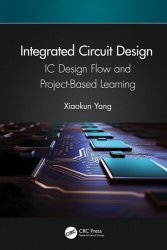Integrated Circuit Design: IC Design Flow and Project-Based Learning
- Добавил: literator
- Дата: 27-10-2024, 23:35
- Комментариев: 0
 Название: Integrated Circuit Design: IC Design Flow and Project-Based Learning
Название: Integrated Circuit Design: IC Design Flow and Project-Based LearningАвтор: Xiaokun Yang
Издательство: CRC Press
Год: 2025
Страниц: 495
Язык: английский
Формат: pdf (true), epub
Размер: 33.9 MB
This textbook seeks to foster a deep understanding of the field by introducing the industry integrated circuit (IC) design flow and offering tape-out or pseudo tape-out projects for hands-on practice, facilitating project-based learning (PBL) experiences.
Integrated Circuit Design: IC Design Flow and Project-Based Learning aims to equip readers for entry-level roles as IC designers in the industry and as hardware design researchers in academia. The book commences with an overview of the industry IC design flow, with a primary focus on register-transfer level (RTL) design, the automation of simulation and verification, and system-on-chip (SoC) integration. To build connections between RTL design and physical hardware, FPGA (field-programmable gate array) synthesis and implementation is utilized to illustrate the hardware description and performance evaluation. The second objective of this book is to provide readers with practical, hands-on experience through tape-out or pseudo tape-out experiments, labs, and projects. These activities are centered on coding format, industry design rules (synthesizable Verilog designs, clock domain crossing, etc.), and commonly-used bus protocols (arbitration, handshaking, etc.), as well as established design methodologies for widely-adopted hardware components, including counters, timers, finite state machines (FSMs), I2C, single/dual-port and ping-pong buffers/register files, FIFOs, floating-point units (FPUs), numerical hardware (Fourier transform, matrix-matrix multiplication, etc.), direct memory access (DMA), image processing designs, neural networks, and more.
Chapter 1 provides a comprehensive review of the history and roadmap of integrated circuit (IC) design industry. It also introduces key aspects of the IC design, encompassing both field-programmable gate arrays(FPGAs) and application-specific integrated circuits (ASICs). Additionally, it offers an overview of Verilog design fundamentals, serving as foundational knowledge for understanding register-transfer level (RTL) design and simulation.
Chapter 2 presents the integrated circuit (IC) design flow. Its aim is to provide an overview of the key steps involved in IC design, which are facilitated by various electronic design automation (EDA) tools catering to different aspects of the process. Broadly, the design flow can be divided into two main phases: the front-end and the back-end. In the front-end phase, designers focus on the design and verification process in the behavioral description stages, encompassing tasks like creating a design specification, register-transfer level (RTL) coding, system-on-chip (SoC) integration, functional verification at both the intellectual property (IP) level and SoC level, and the verification on field-programmable gate arrays (FPGAs). This phase involves describing and verifying the functionality and structure of RTL design. On the other hand, the back-end phase is focused on the physical implementation of the IC.
Chapter 3 introduces the Verilog hardware description language (HDL), covering the fundamentals of synthesizable hardware descriptions using Verilog. project-based learning (PBL) 1–3 demonstrate the design and simulation of basic combinational circuits.
Together with Chapter 3, Chapter 4 delves into the fundamentals of Verilog design methodologies for describing basic hardware. It emphasizes the essential knowledge of RTL designs using Verilog, encompassing topics such as blocking and non-blocking designs, asynchronous and synchronous reset, hierarchical design, and instantiation. PBL 4–5 demonstrate the design and simulation of basic sequential circuits.
...
Chapter 12 provides an introduction to system-on-chip (SoC) design and integration, with a focus on the widely used bus architecture prevalent in the IC design industry: AMBA (Advanced Microcontroller Bus Architecture) AXI (Advanced eXtensible Interface). Additionally, this chapter introduces commonly-used design components on SoCs, including direct access memory (DMA), image processing units, and neural networks. It also explores various design approaches for achieving high-performance computing, emphasizing the tradeoffs between optimizing results and efficiently managing hardware costs, along with a variety of design structures tailored to accommodate diverse specifications.
The textbook caters to a diverse readership, including junior and senior undergraduate students, as well as graduate students pursuing degrees in electrical engineering, computer engineering, computer science, and related fields. The target audience is expected to have a basic understanding of Boolean Algebra and Karnaugh Maps, as well as prior familiarity with digital logic components such as AND/OR gates, latches, and flip-flops. The book will also be useful for entry-level RTL designers and verification engineers who are embarking on their journey in application-specific IC (ASIC) and FPGA design industry.
Скачать Integrated Circuit Design: IC Design Flow and Project-Based Learning
[related-news] [/related-news]
Внимание
Уважаемый посетитель, Вы зашли на сайт как незарегистрированный пользователь.
Мы рекомендуем Вам зарегистрироваться либо войти на сайт под своим именем.
Уважаемый посетитель, Вы зашли на сайт как незарегистрированный пользователь.
Мы рекомендуем Вам зарегистрироваться либо войти на сайт под своим именем.
